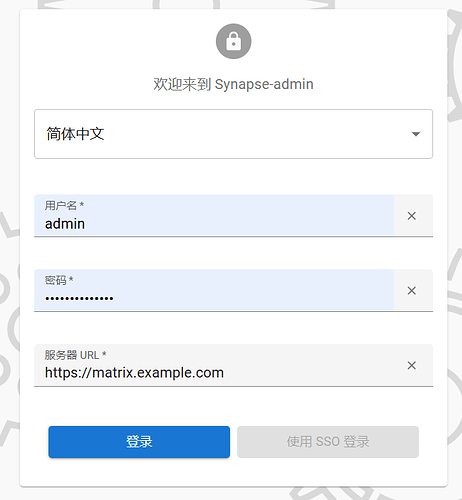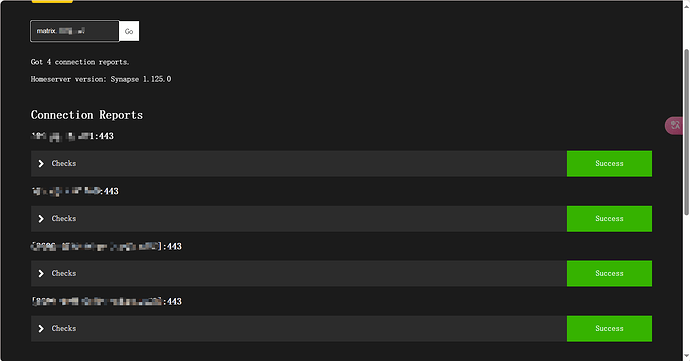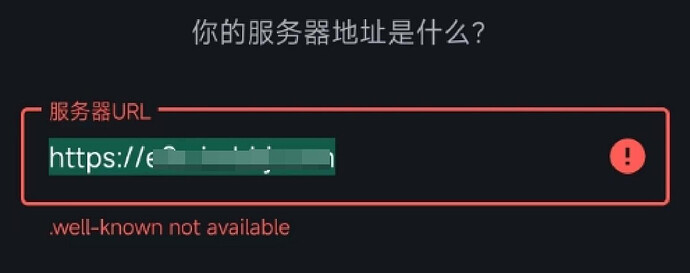简介
Matrix和Synapse都是与去中心化通信相关的重要概念和软件项目,以下从多个方面分别对它们进行介绍:
Matrix
- 定义与定位:Matrix是一个开源的去中心化实时通信协议,旨在为即时通讯、VoIP(网络电话)、物联网等场景提供通用的开放标准。它允许不同的通信应用程序之间进行互操作,打破了传统即时通讯平台之间的壁垒,实现类似于电子邮件系统那样,不同服务商的用户能够相互通信。
- 特点
- 去中心化:Matrix网络由众多独立运行的服务器组成,没有单一的控制中心。每个服务器可以独立管理自己的用户和数据,用户可以选择不同的服务器提供商,增强了数据的安全性和隐私性,也避免了单点故障问题。
- 互操作性:不同的Matrix客户端和服务器可以相互通信,这意味着用户可以根据自己的喜好选择不同的客户端应用,而这些应用都能接入Matrix网络与其他用户交流,就像不同的电子邮件客户端都能收发邮件一样。
- 多功能性:不仅支持文本聊天,还能进行语音通话、视频通话、文件共享等多种通信功能,满足了用户多样化的实时通信需求。
- 应用场景
- 即时通讯:作为一个通用的通信协议,被广泛应用于各种即时通讯应用的开发,许多注重隐私和开放性的聊天工具基于Matrix构建。
- 团队协作:适用于团队内部的沟通协作,支持创建群组聊天、频道等,方便团队成员之间进行信息交流和项目协作。
- 物联网通信:在物联网领域,Matrix可用于设备之间以及设备与用户之间的实时通信,实现设备状态监控、远程控制等功能。
Synapse
- 定义与定位:Synapse是一个用Python编写的Matrix homeserver(家庭服务器,是Matrix网络中运行的服务器实例,负责管理用户账户、存储聊天数据、处理通信请求等)参考实现,由Matrix.org基金会开发和维护。它为搭建Matrix服务器提供了一个可靠且功能丰富的解决方案。
- 特点
- 功能完备:Synapse实现了Matrix协议的大部分功能,包括用户注册与认证、房间管理、消息存储与同步、权限控制等。它可以处理大量的并发用户和消息,具备良好的稳定性和扩展性。
- 易于部署:提供了相对简单的部署方式,支持在多种操作系统和云平台上安装运行。同时,它也有详细的文档和社区支持,方便开发者和管理员进行部署和维护。
- 可定制性:允许管理员根据实际需求进行配置和定制,例如设置服务器的性能参数、安全策略、存储方式等。开发者还可以通过插件机制对其功能进行扩展。
- 应用场景
- 个人服务器搭建:个人用户可以使用Synapse在自己的服务器或云主机上搭建私人的Matrix服务器,完全掌控自己的通信数据,确保隐私安全。
- 企业通信平台:企业可以基于Synapse搭建内部的即时通讯和协作平台,实现员工之间的安全通信和高效协作,同时满足企业对数据安全和管理的要求。
- 公共服务提供商:一些公共的Matrix服务提供商使用Synapse作为其服务器端软件,为广大用户提供Matrix网络接入服务,类似于传统的即时通讯服务提供商。
模型:Doubao-1.5-Pro
部署
需要注意的是,Synapse 的部署比较复杂,网上的教程也很多,当然我在这个过程中踩的坑简直无数了,所以仅供参考。
Synapse 部署有两种模式,单域名和双域名模式,但是这两种模式都推荐(或者要求)使用一级域名,也就是 example.com 来部署 homeserver,官方文档里推荐使用双域名模式,将 8448 联邦端口独立出去,但是也不知道到底是官方的文档写的烂还是我个人理解能力不行,反反复复琢磨了好几次,失败了无数次,终于是放弃了常规的部署方法。
下文中的部署方法完全是我 自己瞎琢磨的,不要求使用一级域名,可以在例如 matrix.example.com 的二级域名上使用(我现在就是这么用的),可以保证能用,但是不保证完全能用(实测有小瑕疵,下文会详细的说明)。
docker-compose.yml 配置文件:
# This compose file is compatible with Compose itself, it might need some
# adjustments to run properly with stack.
# version: '3'
services:
synapse:
# build:
# context: ../..
# dockerfile: docker/Dockerfile
image: docker.io/matrixdotorg/synapse:latest
container_name: matrix-server
# Since synapse does not retry to connect to the database, restart upon
# failure
restart: unless-stopped
# See the readme for a full documentation of the environment settings
# NOTE: You must edit homeserver.yaml to use postgres, it defaults to sqlite
environment:
- SYNAPSE_CONFIG_PATH=/data/homeserver.yaml
volumes:
# You may either store all the files in a local folder
- ./files:/data
# .. or you may split this between different storage points
# - ./files:/data
# - /path/to/ssd:/data/uploads
# - /path/to/large_hdd:/data/media
depends_on:
- db
- element
# In order to expose Synapse, remove one of the following, you might for
# instance expose the TLS port directly:
ports:
- 9008:8008
- 9007:8448
# - 9006:8009
# networks:
# - matrix-network
# ... or use a reverse proxy, here is an example for traefik:
# labels:
# # The following lines are valid for Traefik version 1.x:
# - traefik.enable=true
# - traefik.frontend.rule=Host:my.matrix.Host
# - traefik.port=8008
# # Alternatively, for Traefik version 2.0:
# - traefik.enable=true
# - traefik.http.routers.http-synapse.entryPoints=http
# - traefik.http.routers.http-synapse.rule=Host(`my.matrix.host`)
# - traefik.http.middlewares.https_redirect.redirectscheme.scheme=https
# - traefik.http.middlewares.https_redirect.redirectscheme.permanent=true
# - traefik.http.routers.http-synapse.middlewares=https_redirect
# - traefik.http.routers.https-synapse.entryPoints=https
# - traefik.http.routers.https-synapse.rule=Host(`my.matrix.host`)
# - traefik.http.routers.https-synapse.service=synapse
# - traefik.http.routers.https-synapse.tls=true
# - traefik.http.services.synapse.loadbalancer.server.port=8008
# - traefik.http.routers.https-synapse.tls.certResolver=le-ssl
db:
image: docker.io/postgres:15-alpine
container_name: matrix-database
# ports:
# - 9007:5432/tcp
# networks:
# - matrix-network
# Change that password, of course!
environment:
- POSTGRES_USER=synapse
- POSTGRES_PASSWORD=xxxxxxxxxxxxx
# ensure the database gets created correctly
# https://element-hq.github.io/synapse/latest/postgres.html#set-up-database
- POSTGRES_INITDB_ARGS=--encoding=UTF-8 --lc-collate=C --lc-ctype=C
volumes:
# You may store the database tables in a local folder..
- ./schemas:/var/lib/postgresql/data
# .. or store them on some high performance storage for better results
# - /path/to/ssd/storage:/var/lib/postgresql/data
element:
image: docker.io/vectorim/element-web:latest
container_name: matrix-element
ports:
- 9009:80
volumes:
- ./element-web/config.json:/app/config.json
# networks:
# matrix-network:
# driver: bridge
这份配置文件 必须要修改 的地方只有一处就是数据库密码:
POSTGRES_PASSWORD=:自己自定义一个比较复杂的密码,最好含有大小写和数组和艾特或者点符号,不要有特殊符号,密码要记住,下面还要用。
推荐修改的地方只有:
- Synapse的端口:
9008:8008,前面的9008自己改一个自己喜欢的就行(不要占用其他的服务或者特殊端口即可);9007:8448这个该不该都无所谓,注释了也行。 - Element的端口:
9009:80,同上。
如果不修改端口,那么将
https://matrix.example.com反代到 9008 端口,将https://element.example.com反代到 9009 端口即可。
然后在 yml 文件的当前目录,执行:
docker-compose run --rm -e SYNAPSE_SERVER_NAME=matrix.example.host -e SYNAPSE_REPORT_STATS=no synapse generate
按照提示进行输入即可,会生成一个配置文件,在当前目录下的 ./files/homeserver.yml 中,打开这个文件进行修改:
# Configuration file for Synapse.
#
# This is a YAML file: see [1] for a quick introduction. Note in particular
# that *indentation is important*: all the elements of a list or dictionary
# should have the same indentation.
#
# [1] https://docs.ansible.com/ansible/latest/reference_appendices/YAMLSyntax.html
#
# For more information on how to configure Synapse, including a complete accounting of
# each option, go to docs/usage/configuration/config_documentation.md or
# https://element-hq.github.io/synapse/latest/usage/configuration/config_documentation.html
server_name: "matrix.exacple.com"
pid_file: /data/homeserver.pid
listeners:
- port: 8008
tls: false
type: http
x_forwarded: true # 位于反向代理后面,监听 http 时启用
# bind_addresses: ['::1', '127.0.0.1'] # 监听所有本地流量,docker 部署不要启用
resources:
- names: [client, federation]
compress: false
database:
# name: sqlite3
# args:
# database: /data/homeserver.db
name: psycopg2
args:
user: synapse
password: xxxxxxxxxxxxxx
dbname: synapse
host: db
cp_min: 5
cp_max: 10
# seconds of inactivity after which TCP should send a keepalive message to the server
keepalives_idle: 10
# the number of seconds after which a TCP keepalive message that is not
# acknowledged by the server should be retransmitted
keepalives_interval: 10
# the number of TCP keepalives that can be lost before the client's connection
# to the server is considered dead
keepalives_count: 3
enable_registration: true # 是否允许注册
registration_requires_token: true # 注册是否需要token
serve_server_wellknown: true # 8448 托管到 443
public_baseurl: https://matrix.exacple.com/ # 客户端用于访问该家庭服务器的面向公众的基本 URL
web_client_location: https://element.exacple.com/ # 重定向 / 到 web 客户端
extra_well_known_client_content: # 客户端标头 /.well-known/matrix/client
identity_server: "https://vector.im/"
web_client: "https://element.exacple.com/" # element 客户端的地址
report_stats: false # 匿名发送报告
max_avatar_size: 1M # 默认上传的头像文件大小
log_config: "/data/matrix.example.com.log.config"
media_store_path: /data/media_store
registration_shared_secret: "xxxxxxxxxxxxxxxxxxxxxxxxx"
macaroon_secret_key: "xxxxxxxxxxxxxxxxxxxxxxxxx"
form_secret: "xxxxxxxxxxxxxxxxxxxxxxxxx"
signing_key_path: "/data/matrix.example.com.signing.key"
trusted_key_servers:
- server_name: "matrix.org"
# vim:ft=yaml
注:这里的
serve_server_wellknown: true必须要设置。
将数据库密码修改为 docker-compose.yml 文件中自己修改的,然后修改下面几个配置项:
server_name:如果生成配置的命令中已经修改过了,这里默认是自己matrix的服务端域名即可。public_baseurl:等于server_name即可。web_client_location:部署的element-web客户端的域名。web_client:等于web_client_location即可(可选项)。
下面的xxxxxx部分是自动生成的密钥,默认即可。
然后返回 docker-compose.yml 所在目录,创建一个 element-web 文件夹(如果你docker-compose配置文件没有改element路径的话),在这个文件夹里创建一个 config.json 文件,写入:
{
"default_server_name": "matrix.example.com",
"default_server_config": {
"m.homeserver": {
"base_url": "https://matrix.example.com"
},
"m.identity_server": {
"base_url": "https://vector.im"
}
}
}
更改域名为matrix的服务地址,身份验证服务器默认即可。
然后回到 docker-compose.yml 所在的文件夹,执行 docker compose up -d 启动容器。
等待容器的状态变成 healthy 之后,说明服务已经启动完成了,且没啥毛病。
注册用户
注册管理员账户,进入容器,执行:
register_new_matrix_user http://localhost:8008 -c /data/homeserver.yaml -a
这个命令啥也不用修改,直接在容器内回车执行即可。
按照提示输入管理员账号和密码注册管理员即可。
注册普通账户首先必须确保开启了允许注册:
enable_registration: true:允许注册用户
其次,如果还开启了邀请码:
registration_requires_token: true:注册需要邀请码
那么首先需要生成一个邀请码,通过第三方管理接口进行登录:Synapse-Admin
输入自己的服务地址和刚才创建好的管理员账户和密码,登录,新建一个邀请码:
字段说明:
- Token,这里填入我们想创建的 token 内容,允许为空。
- Length,在 Token 字段为空的情况下,需要填入 Length,会自动生成一个指定长度的随机 token 值。
- Uses allowed,允许 token 使用多少次,填 null(不填)则是无限次。
- Expiry time,token 的过期时间,填 null(不填)则是没有过期时间。
如果不想要别人托管好的管理面板,可以自己再部署一个管理员面板,我这里就懒得弄了,这个管理员面板的仓库:Awesome/synapse-admin ,支持与 docker-compose 集成部署。
然后访问上文部署的 element-web 客户端,也就是 https://element.example.com ,点击注册,输入用户名和密码,输入邀请码即可。
测试联邦
一切就绪之后可以通过官方的这个工具进行测试联邦:Matrix Federation Tester ,访问之后输入自己的 server_name ,点击 Go,结果如图:
我这里是两个 v4 两个 v6,所以是四个,出现绿色的 Success 代表联邦没有问题。
然后访问 https://matrix.example.com/.well-known/matrix/server ,返回结果为:
{
"m.server": "matrix.example.com:443"
}
继续访问 https://matrix.example.com/.well-known/matrix/client ,返回结果为:
{
"m.homeserver": {
"base_url": "https://matrix.example.com/"
},
"identity_server": "https://vector.im/",
"web_client": "https://element.example.com/"
}
说明 8448 委托和客户端标头也都没问题。
当然,最好的测试办法就是去加一个其他服务器的公共聊天,看能否顺利加入和发送消息。
注意
- 域名反代,我用的是 1Panel 默认的 OpenResty,反代 没有任何特殊设置
serve_server_wellknown: true配置项必须要有- 其实 Synapse 的端口暴露 8008 一个即可
- 数据库本地连接 host 直接是 db,也就是数据库 service 的名字即可,因为 docker-compose 默认在同一网络下
- element 手机端 App 的地址要写
element.example.com,直接写matrix.example.com可能会产生如下报错:
瑕疵
我自己琢磨的这套部署方法,忽略了非常非常重要的一点,就是官方文档中所推荐的 8448 端口的监听,并且要将 8448 端口转发到 443,而且官方的反代中还进行了一些特殊的设置,因为我看不明白,所以压根就没弄,不过庆幸的是已经可以用了,也可以访问到其他服务器上的人和群聊,我就没管了。
不过贴上官方的 nginx 反代配置,你能看懂的话可以自己设置:
server {
listen 443 ssl;
listen [::]:443 ssl;
# For the federation port
listen 8448 ssl default_server;
listen [::]:8448 ssl default_server;
server_name matrix.example.com;
location ~ ^(/_matrix|/_synapse/client) {
# note: do not add a path (even a single /) after the port in `proxy_pass`,
# otherwise nginx will canonicalise the URI and cause signature verification
# errors.
proxy_pass http://localhost:8008;
proxy_set_header X-Forwarded-For $remote_addr;
proxy_set_header X-Forwarded-Proto $scheme;
proxy_set_header Host $host:$server_port;
# Nginx by default only allows file uploads up to 1M in size
# Increase client_max_body_size to match max_upload_size defined in homeserver.yaml
client_max_body_size 50M;
# Synapse responses may be chunked, which is an HTTP/1.1 feature.
proxy_http_version 1.1;
}
}
然后有个大佬给了我一份他自己的简单化的配置文件可以供参考:
location / {
proxy_pass http://127.0.0.1:8008;
proxy_set_header Host $host;
proxy_set_header X-Real-IP $remote_addr;
proxy_set_header X-Forwarded-For $proxy_add_x_forwarded_for;
proxy_set_header X-Forwarded-Proto $scheme;
proxy_http_version 1.1;
proxy_set_header Connection "";
}
# .well-known 配置
location /.well-known/matrix/client {
return 200 '{"m.homeserver": {"base_url": "https://matrix.example.com"}}';
default_type application/json;
add_header Access-Control-Allow-Origin *;
}
# 联邦请求代理
location /_matrix/federation {
proxy_pass https://127.0.0.1:8448;
proxy_set_header Host $host;
proxy_set_header X-Real-IP $remote_addr;
proxy_set_header X-Forwarded-For $proxy_add_x_forwarded_for;
proxy_set_header X-Forwarded-Proto $scheme;
}
配置未经测试,请慎重哦~
参考资料
- Synapse 仓库:element-hq/synapse
- Synapse 文档:synapse/installation
- Synapse compose 示例:element-hq/synapse/docker-compose.yml
- element-web 说明:element-hq/element-web/install
- element-web config 示例:element-web/config.json
- Matrix Synapse 服务安装(Docker) | 侯坤林博客
- 超详细 Matrix Synapse 部署教程:搭建去中心化加密聊天服务器 - 白鱼小栈
- Docker部署Matrix&Element | OrdisBlog



